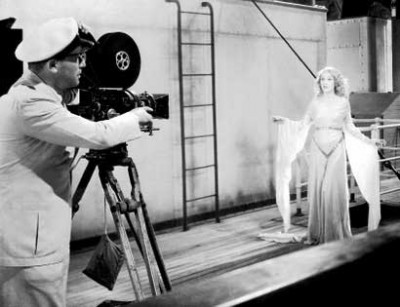 A Scream Queen is an actress who has become associated with horror films, either through an appearance in a notable entry in the genre, as a frequent victim, or through constant appearances as the female protagonist. She belongs to the Damsel-In-Distress family of fictional characters. Long before the term was invented, the Scream Queen has always been a classic figure in world literature, art and film. She is almost inevitably a young nubile woman, who has been placed in a dire predicament by a villain or monster, and who requires a hero to dash to her rescue. The Scream Queen has became a stock character of fiction, particularly in horror. Some claim the popularity of the Scream Queen is primarily because her predicaments sometimes contain hints of sadomasochistic fantasies. The helplessness of the Scream Queen, who is often portrayed as foolish and ineffectual to the point of naivete, along with her need for others to rescue her, has made the stereotype the target of feminist criticism.
A Scream Queen is an actress who has become associated with horror films, either through an appearance in a notable entry in the genre, as a frequent victim, or through constant appearances as the female protagonist. She belongs to the Damsel-In-Distress family of fictional characters. Long before the term was invented, the Scream Queen has always been a classic figure in world literature, art and film. She is almost inevitably a young nubile woman, who has been placed in a dire predicament by a villain or monster, and who requires a hero to dash to her rescue. The Scream Queen has became a stock character of fiction, particularly in horror. Some claim the popularity of the Scream Queen is primarily because her predicaments sometimes contain hints of sadomasochistic fantasies. The helplessness of the Scream Queen, who is often portrayed as foolish and ineffectual to the point of naivete, along with her need for others to rescue her, has made the stereotype the target of feminist criticism.
 The term Scream Queen didn’t really begin to come into use until after the John Carpenter film Halloween (1978). Jamie Lee Curtis almost single-handedly revived the Scream Queen character type for a new generation of actresses and moviegoers. Ever since Michael Myers dressed in a clown suit to kill his older sister, his juices have been flowing every Halloween like clockwork. Fifteen years later, and judging by the point-of-view camera and the heavy breathing, we know Michael is stalking brainy Jamie Lee, a studious high-schooler and a champion babysitter. The reason we know from the start that Jamie Lee is going to live to carve yet another pumpkin, is because she doesn’t date. As everyone knows, premarital sex is the most reliable indicator of impending death in slasher movies. “Guys think I’m too smart,” mourns the dateless Laurie Strode, who will spend a harrowing night being stalked in the first of the Halloween film franchise. In the slice-and-dice genre, only the one virginal girl in the bunch gets to outwit the serial killer. All of Laurie’s sexually active friends get punished for their lascivious ways while Laurie makes popcorn and reads bedtime stories to her young charge. The intelligence that kept the men at bay allows Laurie to use her head when all about her are losing theirs – literally.
The term Scream Queen didn’t really begin to come into use until after the John Carpenter film Halloween (1978). Jamie Lee Curtis almost single-handedly revived the Scream Queen character type for a new generation of actresses and moviegoers. Ever since Michael Myers dressed in a clown suit to kill his older sister, his juices have been flowing every Halloween like clockwork. Fifteen years later, and judging by the point-of-view camera and the heavy breathing, we know Michael is stalking brainy Jamie Lee, a studious high-schooler and a champion babysitter. The reason we know from the start that Jamie Lee is going to live to carve yet another pumpkin, is because she doesn’t date. As everyone knows, premarital sex is the most reliable indicator of impending death in slasher movies. “Guys think I’m too smart,” mourns the dateless Laurie Strode, who will spend a harrowing night being stalked in the first of the Halloween film franchise. In the slice-and-dice genre, only the one virginal girl in the bunch gets to outwit the serial killer. All of Laurie’s sexually active friends get punished for their lascivious ways while Laurie makes popcorn and reads bedtime stories to her young charge. The intelligence that kept the men at bay allows Laurie to use her head when all about her are losing theirs – literally.
 Jamie Lee continued to scream her way through such movies as The Fog (1980), Prom Night (1980), Terror Train (1980), Road Games (1981) and Halloween II (1981). But that guys thought Laurie was too smart is an apt description of Jamie Lee’s career with her strong jaw-line and even stronger bloodline (she is the daughter of Tony Curtis and Janet Leigh), Jamie Lee graduated from Scream Queen to more intelligent roles, with a brief stopover for that indelible nude scene in Trading Places (1983). She’s strong, and yet she still seems to attract psycho killers. As a mannish cop in Blue Steel (1989), she winds up with a boyfriend who likes her for her trigger-finger, and in Virus (1999) she is stalked by a robot-zombie Donald Sutherland. But Jamie Lee brought something new to the old equation – a steely toughness that would allow her to take on her attacker rather than just waiting around for him to make mincemeat of her. Sure, she may have needed Doctor Loomis to help her finish the job in Halloween, but the fact that she fought back at all sets her quite apart from many of her predecessors. This new twist on the traditional role would become a key element in many of the slasher flicks that would follow.
Jamie Lee continued to scream her way through such movies as The Fog (1980), Prom Night (1980), Terror Train (1980), Road Games (1981) and Halloween II (1981). But that guys thought Laurie was too smart is an apt description of Jamie Lee’s career with her strong jaw-line and even stronger bloodline (she is the daughter of Tony Curtis and Janet Leigh), Jamie Lee graduated from Scream Queen to more intelligent roles, with a brief stopover for that indelible nude scene in Trading Places (1983). She’s strong, and yet she still seems to attract psycho killers. As a mannish cop in Blue Steel (1989), she winds up with a boyfriend who likes her for her trigger-finger, and in Virus (1999) she is stalked by a robot-zombie Donald Sutherland. But Jamie Lee brought something new to the old equation – a steely toughness that would allow her to take on her attacker rather than just waiting around for him to make mincemeat of her. Sure, she may have needed Doctor Loomis to help her finish the job in Halloween, but the fact that she fought back at all sets her quite apart from many of her predecessors. This new twist on the traditional role would become a key element in many of the slasher flicks that would follow.
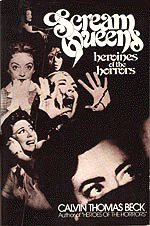 The year 1978 also saw the publication of the book Scream Queens by Calvin Beck, the editor of Castle Frankenstein magazine, a highly literate semi-professional publication. Beck’s book covered a number of genre-related actresses from the thirties to the sixties. However, the book was decidedly ‘small press’ and the two-word title wouldn’t really become part of the public consciousness until the early eighties with the last gasp of theatrical horror films like Nightmare Sisters (1987) and Sorority Babes In The Slimeball Bowl-O-Rama (1988). The three actresses primarily associated with those films (Brinke Stevens, Linnea Quigley, Michelle Bauer) pretty much had the field all to themselves.
The year 1978 also saw the publication of the book Scream Queens by Calvin Beck, the editor of Castle Frankenstein magazine, a highly literate semi-professional publication. Beck’s book covered a number of genre-related actresses from the thirties to the sixties. However, the book was decidedly ‘small press’ and the two-word title wouldn’t really become part of the public consciousness until the early eighties with the last gasp of theatrical horror films like Nightmare Sisters (1987) and Sorority Babes In The Slimeball Bowl-O-Rama (1988). The three actresses primarily associated with those films (Brinke Stevens, Linnea Quigley, Michelle Bauer) pretty much had the field all to themselves.
The publisher of Cinefantastique magazine, Fred Clarke, created a separate publication called Femme Fatales, which began as a periodical specifically about Scream Queen actresses who specialised in genre films including science fiction, fantasy and mystery. Clarke soon realised the field was too narrow, and broadened the scope of the magazine to include better-known actresses (Raquel Welch, Dee Wallace Stone, Linda Blair) who had appeared in one or more genre films but were better known for their mainstream work. In the wake of Femme Fatales came Scream Queens Illustrated, published by John Russo, which solidified the legitimacy of the phrase Scream Queen, if not the accuracy. The magazine publicised many of the same actresses with accompanying glamour photo layouts, but also promoted would-be Scream Queens who had scarcely appeared in more than a few backyard videos. Eventually even the pretense of cinema accomplishment was dropped, and Scream Queens Illustrated simply ran sexy girl photo features, proclaiming the model as a potential Scream Queen.
 Contrary to popular belief, the term Scream Queen was never applied to actress Fay Wray during her acting career, though she had certainly done more than her fair share of screaming in King Kong (1933). The target of Kong’s affections was the lovely Fay, who would claim her position as the cinema’s first Scream Queen (long before the term was even invented) with an eardrum-shattering performance. Fay also screamed in Mystery Of The Wax Museum (1933) during a break in the filming of King Kong. The special effects on Kong took so long to do, the cast were able to make other films while waiting for their next scene. Fay also made The Most Dangerous Game (1932) and Doctor X (1932) during these breaks. Born in Canada in 1907, Fay was appearing in routine westerns by the mid-twenties. She met Erich Von Stroheim and he was sufficiently impressed to cast her – without a screen test – as the leading lady in his film The Wedding March (1928). Whilst it was a box-office disaster, The Wedding March was a superb film which got her noticed. Soon after she was the leading lady in the first version of the frequently filmed Four Feathers (1929). After the mid-thirties she was no longer offered the leading roles in major pictures that her talent deserved, just a few minor appearances during the forties and fifties as her stardom slipped away. In 1998 she was guest of honour at a London screening of the restored and re-scored The Wedding March. She passed away in 2004 aged ninety-seven. At least she got the long life she deserved and, courtesy of King Kong, she has a permanent place in cinema history. But prior to Kong and then afterward, Fay’s long career didn’t rely on her lung power, and her films were mostly mainstream dramas and comedies. However, she can be said to have been one of the most famous examples of a Scream Queen within the movie King Kong, although this film does not convey her usual acting style for the remainder of her career.
Contrary to popular belief, the term Scream Queen was never applied to actress Fay Wray during her acting career, though she had certainly done more than her fair share of screaming in King Kong (1933). The target of Kong’s affections was the lovely Fay, who would claim her position as the cinema’s first Scream Queen (long before the term was even invented) with an eardrum-shattering performance. Fay also screamed in Mystery Of The Wax Museum (1933) during a break in the filming of King Kong. The special effects on Kong took so long to do, the cast were able to make other films while waiting for their next scene. Fay also made The Most Dangerous Game (1932) and Doctor X (1932) during these breaks. Born in Canada in 1907, Fay was appearing in routine westerns by the mid-twenties. She met Erich Von Stroheim and he was sufficiently impressed to cast her – without a screen test – as the leading lady in his film The Wedding March (1928). Whilst it was a box-office disaster, The Wedding March was a superb film which got her noticed. Soon after she was the leading lady in the first version of the frequently filmed Four Feathers (1929). After the mid-thirties she was no longer offered the leading roles in major pictures that her talent deserved, just a few minor appearances during the forties and fifties as her stardom slipped away. In 1998 she was guest of honour at a London screening of the restored and re-scored The Wedding March. She passed away in 2004 aged ninety-seven. At least she got the long life she deserved and, courtesy of King Kong, she has a permanent place in cinema history. But prior to Kong and then afterward, Fay’s long career didn’t rely on her lung power, and her films were mostly mainstream dramas and comedies. However, she can be said to have been one of the most famous examples of a Scream Queen within the movie King Kong, although this film does not convey her usual acting style for the remainder of her career.
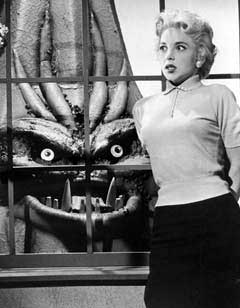 Likewise, contemporary publicity featuring forties Scream Queen Evelyn Ankers never used the term, though Evelyn made more than her share of horror films, like The Wolf Man (1941) and Ghost Of Frankenstein (1942), nor did critics classify Beverly Garland with the obvious title, though she too did plenty of yelling. Beverly Garland did battle with some of the most ludicrous monsters in cinematic history as the star of fifties B-movies such as Swamp Women (1955) and It Conquered The World (1956). She later went on to play Fred MacMurray’s wife in My Three Sons, one of the longest-running situation comedies ever. Swamp Women and It Conquered The World (in which she fought a giant cucumber from Venus) were directed by Roger Corman. Many considered Beverly Garland the most striking of the inexpensive, unknown actors in Corman’s stable, and she later reflected: “I always considered myself a serious actress, and so to be remembered for these pieces of cheese used to be hard to swallow. Roger was so serious when directing that we took the lead and were serious too. I look at the movies now, and with age and hindsight giggle because they are so ridiculous. And yet it’s these that earned me the most fan mail.” Connoisseurs of the genre will also remember Beverly’s appearances in films such as The Alligator People (1959), Not Of This Earth (1957) and Naked Paradise (1957). Far from being a helpless female requiring rescue by the handsome hunk, her character was usually feisty and courageous.
Likewise, contemporary publicity featuring forties Scream Queen Evelyn Ankers never used the term, though Evelyn made more than her share of horror films, like The Wolf Man (1941) and Ghost Of Frankenstein (1942), nor did critics classify Beverly Garland with the obvious title, though she too did plenty of yelling. Beverly Garland did battle with some of the most ludicrous monsters in cinematic history as the star of fifties B-movies such as Swamp Women (1955) and It Conquered The World (1956). She later went on to play Fred MacMurray’s wife in My Three Sons, one of the longest-running situation comedies ever. Swamp Women and It Conquered The World (in which she fought a giant cucumber from Venus) were directed by Roger Corman. Many considered Beverly Garland the most striking of the inexpensive, unknown actors in Corman’s stable, and she later reflected: “I always considered myself a serious actress, and so to be remembered for these pieces of cheese used to be hard to swallow. Roger was so serious when directing that we took the lead and were serious too. I look at the movies now, and with age and hindsight giggle because they are so ridiculous. And yet it’s these that earned me the most fan mail.” Connoisseurs of the genre will also remember Beverly’s appearances in films such as The Alligator People (1959), Not Of This Earth (1957) and Naked Paradise (1957). Far from being a helpless female requiring rescue by the handsome hunk, her character was usually feisty and courageous.
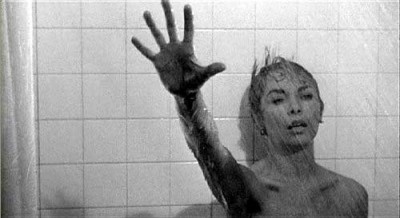 The actress-mother of Scream Queen Jamie Lee Curtis, Janet Leigh was also never referred to in contemporary reviews and press releases as a Scream Queen, however memorable her screeching in the Bates Motel shower in Psycho (1960). I’ll admit I have a weakness for naughty girls, and Janet Leigh seemed so naughty at the beginning of Psycho – a rather manipulative woman with her mind on her money and money on her mind. After robbing her employer, she has the bad fortune to end up at the Bates Motel, guest of the reclusive Norman Bates and his…um, mother. This, of course, leads to one of the most jarring moments of cinema, when a shower scene that threatens to get steamy, instead turns into a chocolate syrup-soaked fake bloodbath and probably the most famous slasher movie moment of all time. Did she get her just desserts for scheming and stealing? I don’t know, but her piercing screams and the mutilation of her lovely, soapy body have stuck with me through many, many years. Fortunately, fans that like seeing Janet in horrific situations have a lot more on which to hang their hat, including a battle against giant rabbits in Night Of The Lepus (1972) and a rather postmodern part in Halloween H20: Twenty Years Later (1998). Like Fay Wray and Beverly Garland and most other so-called Scream Queens, Janet Leigh was better known for her non-genre roles.
The actress-mother of Scream Queen Jamie Lee Curtis, Janet Leigh was also never referred to in contemporary reviews and press releases as a Scream Queen, however memorable her screeching in the Bates Motel shower in Psycho (1960). I’ll admit I have a weakness for naughty girls, and Janet Leigh seemed so naughty at the beginning of Psycho – a rather manipulative woman with her mind on her money and money on her mind. After robbing her employer, she has the bad fortune to end up at the Bates Motel, guest of the reclusive Norman Bates and his…um, mother. This, of course, leads to one of the most jarring moments of cinema, when a shower scene that threatens to get steamy, instead turns into a chocolate syrup-soaked fake bloodbath and probably the most famous slasher movie moment of all time. Did she get her just desserts for scheming and stealing? I don’t know, but her piercing screams and the mutilation of her lovely, soapy body have stuck with me through many, many years. Fortunately, fans that like seeing Janet in horrific situations have a lot more on which to hang their hat, including a battle against giant rabbits in Night Of The Lepus (1972) and a rather postmodern part in Halloween H20: Twenty Years Later (1998). Like Fay Wray and Beverly Garland and most other so-called Scream Queens, Janet Leigh was better known for her non-genre roles.
 English actress Barbara Steele and Polish actress Ingrid Pitt are possibly the two actresses most commonly tagged with the Scream Queen label. I guess it’s all that long black hair and impossibly big eyes that gets Barbara cast in these kinds of roles. I think it was actually illegal to make a Spaghetti Horror film in the sixties without Barbara Steele. During that period she appeared in an amazing thirty-two unforgettable films and one real stinker (I’ll let you work out which) from the seminal Black Sunday (1960) to Revenge Of The Blood Beast (1966), and she worked with master directors as diverse as Mario Bava, Lucio Fulci, Frederico Fellini, David Cronenberg, Jonathan Demme and the one thing that rules them all and in the darkness binds them, Roger Corman. The seventies saw a lot of American television work for Barbara, usually playing-up her distinctive European looks or her career as the previous decade’s leading Scream Queen. Personally, I think her most horrific work will always be as associate producer on Queer Eye For The Straight Guy in 2002. Anyway, she was famously displeased with the typecasting, making it quite clear “I never want to climb out of another freakin’ coffin again!”
English actress Barbara Steele and Polish actress Ingrid Pitt are possibly the two actresses most commonly tagged with the Scream Queen label. I guess it’s all that long black hair and impossibly big eyes that gets Barbara cast in these kinds of roles. I think it was actually illegal to make a Spaghetti Horror film in the sixties without Barbara Steele. During that period she appeared in an amazing thirty-two unforgettable films and one real stinker (I’ll let you work out which) from the seminal Black Sunday (1960) to Revenge Of The Blood Beast (1966), and she worked with master directors as diverse as Mario Bava, Lucio Fulci, Frederico Fellini, David Cronenberg, Jonathan Demme and the one thing that rules them all and in the darkness binds them, Roger Corman. The seventies saw a lot of American television work for Barbara, usually playing-up her distinctive European looks or her career as the previous decade’s leading Scream Queen. Personally, I think her most horrific work will always be as associate producer on Queer Eye For The Straight Guy in 2002. Anyway, she was famously displeased with the typecasting, making it quite clear “I never want to climb out of another freakin’ coffin again!”
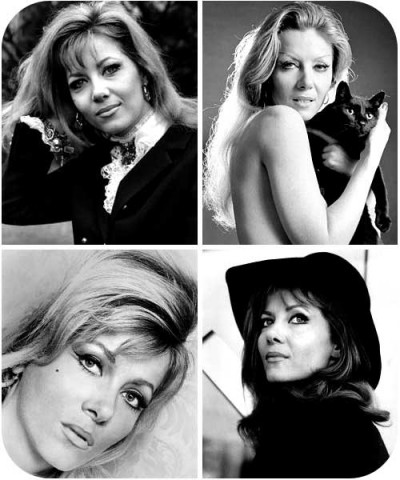 On the other hand, Ingrid Pitt embraced her cult status. Having found fame in Hammer horror films, often as scheming, evil characters, she established a fanclub, wrote an autobiography, and continued to write a regular column for Shivers magazine. She knew it then, knows it now. Seen in The Vampire Lovers (1970) as a super-gorgeous vampire, Ingrid was the hottest of the Hammer girls. Her Countess Dracula (1971), an evil old countess who bathes in virgins blood to make herself youthful – resulted in two of the sexiest movies ever to come out of that studio in the seventies, simply because she was in them. She also stole the show with a small role in the Christopher Lee classic The Wicker Man (1973). She’s still doing horror to this day, most recently in an adaptation of The Tell Tale Heart (2009).
On the other hand, Ingrid Pitt embraced her cult status. Having found fame in Hammer horror films, often as scheming, evil characters, she established a fanclub, wrote an autobiography, and continued to write a regular column for Shivers magazine. She knew it then, knows it now. Seen in The Vampire Lovers (1970) as a super-gorgeous vampire, Ingrid was the hottest of the Hammer girls. Her Countess Dracula (1971), an evil old countess who bathes in virgins blood to make herself youthful – resulted in two of the sexiest movies ever to come out of that studio in the seventies, simply because she was in them. She also stole the show with a small role in the Christopher Lee classic The Wicker Man (1973). She’s still doing horror to this day, most recently in an adaptation of The Tell Tale Heart (2009).
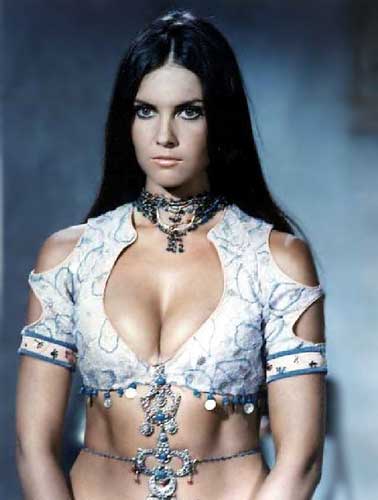 Ingrid was very charismatic and very beautiful, but possibly the sexiest Hammer girl was Caroline Munro, who seduced audiences with her role as a hippy vampire follower in Dracula AD 1972 (1972), before showing-off her figure in The Golden Voyage Of Sinbad (1974) and The Spy Who Loved Me (1977). For gore hounds, she’s probably best remembered as the co-star of Maniac (1980). Her most unusual role was probably as Mrs. Phibes, the late wife of The Abominable Doctor Phibes (1971): She only ever appears in a photo.
Ingrid was very charismatic and very beautiful, but possibly the sexiest Hammer girl was Caroline Munro, who seduced audiences with her role as a hippy vampire follower in Dracula AD 1972 (1972), before showing-off her figure in The Golden Voyage Of Sinbad (1974) and The Spy Who Loved Me (1977). For gore hounds, she’s probably best remembered as the co-star of Maniac (1980). Her most unusual role was probably as Mrs. Phibes, the late wife of The Abominable Doctor Phibes (1971): She only ever appears in a photo.
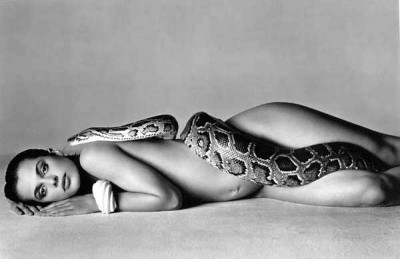 Yet another Hammer horror graduate is Nastassja Kinski (daughter of eccentric actor Klaus Kinski), who started her screaming career in To The Devil A Daughter (1976). Among the eighties nostalgia-buffs, Nastassja will be remembered for the mesmerising ‘snake’ poster she posed for. That image, shot by Richard Avedon, had a snake coiled around her body and has become iconic. But for eighties horror fans, she’s remembered for her role in Paul Shrader’s remake of Cat People (1982). Taking over for the role of Simone Simon in the original, Nastassja’s image with cat eyes on the film’s poster is almost as memorable as her Avedon poster. The movie didn’t quite work, but Nastassja was gorgeous in it, and very well cast. Needless to say, it was a hit at the box-office, and Nastassja received a Saturn Award for Best Actress.
Yet another Hammer horror graduate is Nastassja Kinski (daughter of eccentric actor Klaus Kinski), who started her screaming career in To The Devil A Daughter (1976). Among the eighties nostalgia-buffs, Nastassja will be remembered for the mesmerising ‘snake’ poster she posed for. That image, shot by Richard Avedon, had a snake coiled around her body and has become iconic. But for eighties horror fans, she’s remembered for her role in Paul Shrader’s remake of Cat People (1982). Taking over for the role of Simone Simon in the original, Nastassja’s image with cat eyes on the film’s poster is almost as memorable as her Avedon poster. The movie didn’t quite work, but Nastassja was gorgeous in it, and very well cast. Needless to say, it was a hit at the box-office, and Nastassja received a Saturn Award for Best Actress.
 The rise of the slasher sub-genre in the early eighties and its re-emergence in the mid-to-late nineties led to overuse of the term in mainstream media as as convenient and lazy shorthand. Bouncy Adrienne Barbeau first came to my attention as a small-town radio deejay in John Carpenter’s The Fog (1980). Perched atop her lonely radio tower, Adrienne’s character served as narrator as the ominous mist made its way to the shores of Antonio Bay, her sultry voice providing a small dose of comfort as the vengeful ghosts approached the defenseless town. Soon after I saw her as Harry Dean Stanton’s ‘squeeze’ in Escape From New York (1981). Adrienne then went on to play the naked Damsel-In-Distress in Wes Craven’s Swamp Thing (1982) and appeared as a deserving victim in the George Romero/Stephen King collaboration Creepshow (1982). The former Mrs. John Carpenter has always brought a sexy maturity to even her silliest roles, and her rather healthy set of, ahem, lungs allowed her to scream with the best of them. Adrienne has since gone on to provide the voice of Catwoman in Batman Animated and played a carny in the television series Carnivale. Other Adrienne Barbeau screamers include The Darker Side Of Terror (1979), Open House (1987), Two Evil Eyes (1991), Burial Of The Rats (1995), The Convent (2000), Ring Of Darkness (2004) and Unholy (2007).
The rise of the slasher sub-genre in the early eighties and its re-emergence in the mid-to-late nineties led to overuse of the term in mainstream media as as convenient and lazy shorthand. Bouncy Adrienne Barbeau first came to my attention as a small-town radio deejay in John Carpenter’s The Fog (1980). Perched atop her lonely radio tower, Adrienne’s character served as narrator as the ominous mist made its way to the shores of Antonio Bay, her sultry voice providing a small dose of comfort as the vengeful ghosts approached the defenseless town. Soon after I saw her as Harry Dean Stanton’s ‘squeeze’ in Escape From New York (1981). Adrienne then went on to play the naked Damsel-In-Distress in Wes Craven’s Swamp Thing (1982) and appeared as a deserving victim in the George Romero/Stephen King collaboration Creepshow (1982). The former Mrs. John Carpenter has always brought a sexy maturity to even her silliest roles, and her rather healthy set of, ahem, lungs allowed her to scream with the best of them. Adrienne has since gone on to provide the voice of Catwoman in Batman Animated and played a carny in the television series Carnivale. Other Adrienne Barbeau screamers include The Darker Side Of Terror (1979), Open House (1987), Two Evil Eyes (1991), Burial Of The Rats (1995), The Convent (2000), Ring Of Darkness (2004) and Unholy (2007).
 Any eighties horror aficionado should know who Barbara Crampton is and why she stacks up as one of the most gorgeous and talented horror movie icons of the era. A familiar face to soap opera fans in the eighties, she blew audiences away with her role in the Full Moon Entertainment film Re-Animator (1985) and its follow-up From Beyond (1986). Other Barbara Crampton screamers include Chopping Mall (1986), Puppet Master (1989) and Castle Freak (1995).
Any eighties horror aficionado should know who Barbara Crampton is and why she stacks up as one of the most gorgeous and talented horror movie icons of the era. A familiar face to soap opera fans in the eighties, she blew audiences away with her role in the Full Moon Entertainment film Re-Animator (1985) and its follow-up From Beyond (1986). Other Barbara Crampton screamers include Chopping Mall (1986), Puppet Master (1989) and Castle Freak (1995).
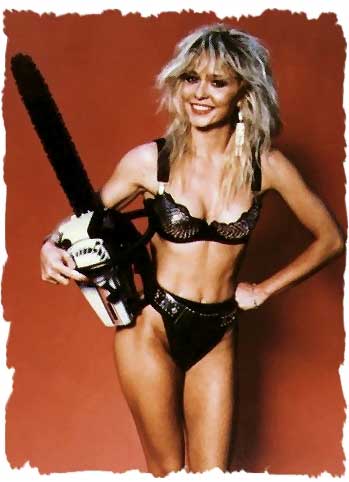 Another eighties Scream Queen is Linnea Quigley, best known for her role in The Return Of The Living Dead (1985). She has also starred in dozens of other horror films including Nightmare Sisters (1987), Creepozoids (1987), Sorority Babes In The Slimeball Bowl-O-Rama (1988), Night Of The Demons (1988) and A Nightmare On Elm Street IV: The Dream Master (1988). Linnea is also the author of two books about her career as a Scream Queen: Chainsaw, and I’m Screaming As Fast As I Can.
Another eighties Scream Queen is Linnea Quigley, best known for her role in The Return Of The Living Dead (1985). She has also starred in dozens of other horror films including Nightmare Sisters (1987), Creepozoids (1987), Sorority Babes In The Slimeball Bowl-O-Rama (1988), Night Of The Demons (1988) and A Nightmare On Elm Street IV: The Dream Master (1988). Linnea is also the author of two books about her career as a Scream Queen: Chainsaw, and I’m Screaming As Fast As I Can.
The term Scream Queen can often be misleading. Sarah Michelle Gellar is often considered a modern day Scream Queen because of the successful genre movies she has appeared in, including The Grudge (2004), The Grudge II (2006), Scream II (1997), I Know What You Did Last Summer (1997) The Return (2006) and Possession (2009). Yet, since she is the female protagonist in most of her work, the term is also valid. In addition to the films listed above, let’s also not forget that she played Daphne in both Scooby-Doo (2002) movies. However, Sarah’s reign as a Scream Queen might ultimately be diminished by the fact that she will always be associated with Buffy The Vampire Slayer, a role meant to inspire fear rather than express it, making it easy to overlook the fact that Sarah has played more than her fair share of victims.
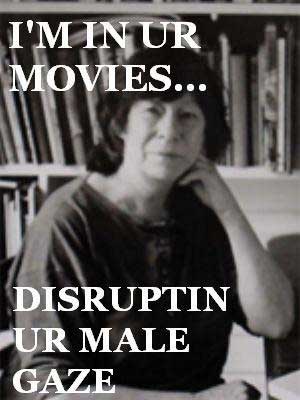 Considering the way that horror films are put together, many feminist film critics have pointed to the so-called ‘male gaze’ that predominates traditional horror movie-making. Laura Mulvey‘s essay Visual Pleasure And Narrative Cinema gives one of the most widely influential versions of this argument. This argument holds that through the use of various film techniques such as the point-of-view shot, a typical viewer becomes aligned with the point-of-view of its male protagonist. Notably, the Scream Queen simply functions as an object of this gaze far more often than as proxies for the spectator. I’m terribly sorry to be leaving you with such a bleak and downbeat image, but be warned, I will not accept that as a valid reason for your not returning next week. I’d miss you too much. So please join me again as I discuss the brutal slashing of budgets and death by a thousand cut corners for…Horror News! Toodles!
Considering the way that horror films are put together, many feminist film critics have pointed to the so-called ‘male gaze’ that predominates traditional horror movie-making. Laura Mulvey‘s essay Visual Pleasure And Narrative Cinema gives one of the most widely influential versions of this argument. This argument holds that through the use of various film techniques such as the point-of-view shot, a typical viewer becomes aligned with the point-of-view of its male protagonist. Notably, the Scream Queen simply functions as an object of this gaze far more often than as proxies for the spectator. I’m terribly sorry to be leaving you with such a bleak and downbeat image, but be warned, I will not accept that as a valid reason for your not returning next week. I’d miss you too much. So please join me again as I discuss the brutal slashing of budgets and death by a thousand cut corners for…Horror News! Toodles!
 Horror News | HNN Official Site | Horror Movies,Trailers, Reviews
Horror News | HNN Official Site | Horror Movies,Trailers, Reviews
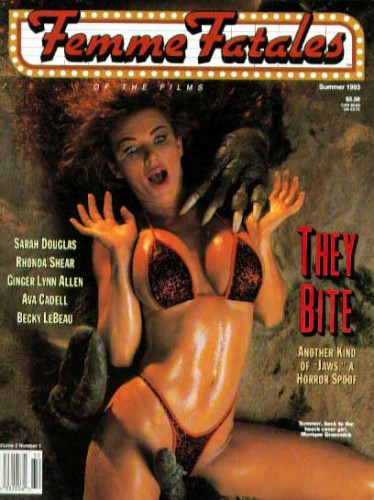

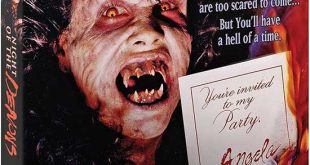
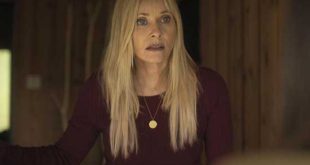

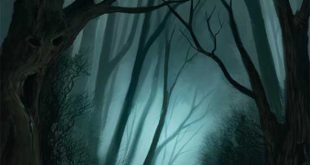
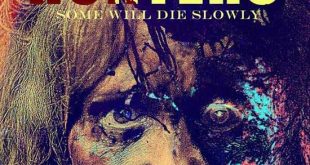
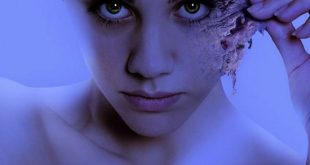
http://www.facebook.com/DrawbridgeOfTheCastle?ref=tn_tnmn
Facebook page devoted to the original Castle Of Frankenstein magazine.
Thanks for reading! Unfortunately the magazine ran only 25 issues, plus one annual; the final issue was published in 1975. Beck cancelled his magazine not because of poor sales but to devote his energy to writing books. During its primary run, Castle of Frankenstein outlasted the majority of monster magazines that filled the market for two decades, with the notable exception of Famous Monsters of Filmland.